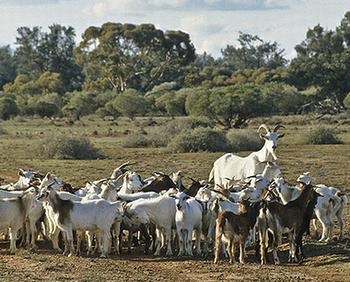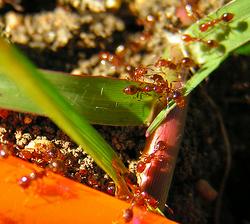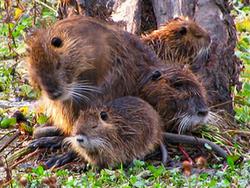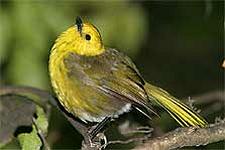Winning Battles But Losing the War on Invasive Alien Species
GLAND, Switzerland, February 4, 2010 (ENS) - Invasive alien species are one of the top three threats to the biodiversity of life on Earth, according to the first assessment report on invasives in 57 countries coordinated by the Global Invasive Species Programme, GISP.
Invasives can be rats, mice, foxes, goats, toads, fish, plants, ants or micro-organisms, to list a few. Spread around the planet by international travel, trade, and tourism, these alien invaders are jeopardizing global biodiversity by out-competing native species for resources, altering ecosystem functions and changing ecological relationships among native species.
 |
Feral goats in New South Wales, Australia trample soils, degrading soil stability and causing erosion. Goats can be helpful when they are set to graze on invasive plants. (Photo courtesy Govt. NSW) |
GISP Executive Director Dr. Sarah Simons said, "Despite the enormous costs, not only to biodiversity but also food security, human health, trade, transport and more broadly, economic development, invasive species continue to receive inadequate attention from policymakers and in 2010, there is simply no excuse for not tackling one of the greatest threats to the environmental and economic well-being of our planet."
The international team of investigators who wrote the GISP report documented a total of 542 species acting as invasive aliens - 316 plants, 101 marine organisms, 44 freshwater fish, 43 mammal, 23 bird and 15 amphibian species.
Professor Melodie McGeoch, lead author of the report and member of the Centre for Invasion at South Africa's Stellenbosch University, says these numbers underestimate the extent of invasive aliens.
"We showed that regions with low development status and little investment in research have lower than expected numbers of invasive aliens," said McGeoch.
Only nine invasive species were found in Equatorial Guinea, according to the report, but 222 invasive species were counted in New Zealand.
The report was produced by scientists from the Centre for Invasion Biology, BirdLife International, based in the UK; and the International Union for the Conservation of Nature, IUCN, based in Switzerland, which maintains the authoritative Red List of Threatened Species.
Of the 57 countries assessed, they found that, on average, there are 50 non-indigenous species per country which have a negative impact on biodiversity.
Invasive alien species can directly affect human health and humans can be the carriers of invasive species into new locations. Infectious diseases are often invasive species imported by travelers, or they can be diseases carried by exotic species of birds, rodents and insects or by humans.
The pathogenic chytrid fungus, for instance, entirely unknown until 1998, is thought to be the cause of the decline and extinction of many amphibians around the globe. The disease caused by the fungus can be spread by humans and a host of other species, ranging from exotic fish to African clawed frogs.
Invasives also can have indirect health effects on humans as a result of the use of pesticides and herbicides that contaminate water and soil.
The Global Invasive Species Database lists 100 of the worst invasive alien species. Species were selected for the list according to two criteria - their serious impact on biological diversity and/or human activities, and their illustration of important issues surrounding biological invasion.
Ten of the worst are:
- The Asian tiger mosquito, Aedes albopictus, is spread via
the international tire trade as rainwater isretained in tires stored
outside. In order to control its spread such trading routes must be
highlighted for the introduction of sterilization or quarantine
measures. The tiger mosquito is associated with the transmission of
many human diseases, including the viruses dengue, West Nile and
Japanese encephalitis.

Fire ants in Texas (Photo by Mary Kilgore)
- The little fire ant, Wasmannia auropunctata, is blamed
for reducing species diversity, reducing overall abundance of flying
and tree-dwelling insects, and eliminating arachnid populations. It
is also known for its painful stings. On the Galapagos Islands, it
eats the hatchlings of tortoises and attacks the eyes and cloacae of
the adult tortoises. It is considered to be perhaps the greatest ant
species threat in the Pacific region.
- The brown tree snake, Boiga irregularis, is secretive by
nature. It is often found concealed on container ships and in
aircraft cargo. It probably arrived on Guam after World War II in a
cargo ship. Now the wetlands, coastlands and forests of Guam are
bereft of nine out of twelve native bird species and two out of 11
native lizards due to the snakes' voracious appetite.
- Zebra mussels, Dreissena polymorpha, are native to the
Caspian and Black Seas. They are now established in the UK, Western
Europe, Canada and the USA. They compete with zooplankton for food,
thus affecting natural food webs. They also interfere with the
ecological functions of native molluscs and cause great economic
damage.
- The Nile perch, Lates niloticus, is a large freshwater
fish. Also known as capitaine, mputa or sangara, it can grow up to
200kg and two metres in length. It was introduced to Lake Victoria
in 1954 where it has contributed to the extinction of more than 200
endemic fish species through predation and competition for food.
- The coqui frog, Eleutherodactylus coqui, is a relatively
small tree frog native to Puerto Rico. The frogs are quite adaptable
to different ecological zones and elevations. Their loud call is the
main reason they are considered a pest. E. coqui's mating call is
its namesake, a high-pitched, two-note "co-qui" which attains nearly
100 decibels at 0.5 metres. E. coqui have a voracious appetite and
there is concern in Hawaii, where it has been introduced, that E.
coqui may put Hawaii's endemic insect and spider species at risk and
compete with endemic birds and other native fauna which rely on
insects for food.
- The house mouse, Mus musculus, probably has a world
distribution more extensive than any mammal, apart from humans. Its
geographic spread has been facilitated by its commensal relationship
with humans which extends back at least 8,000 years. They do
considerable damage by destroying crops and consuming and/or
contaminating food supplies intended for human consumption. They are
prolific breeders, sometimes erupting and reaching plague
proportions. They have also been implicated in the extinction of
indigenous species in ecosytems they have invaded and colonized.

Nutria family in Louisiana (Photo by Julie Alicea)
- The coypu or nutria, Myocastor coypus, is a large
semi-aquatic rodent that originated from South America. Due to
escapes and releases from fur farms there are now large feral
populations in North America, Europe and Asia. Their burrows
penetrate and damage river banks, dykes and irrigation facilities.
Feeding methods lead to the destruction of large areas of reed
swamp. Habitat loss caused by coypus impacts plant, insect, bird and
fish species.
- A native of the Indian sub-continent, the ship rat, Rattus
rattus, has now spread throughout the world. It is widespread in
forest and woodlands as well as being able to live in and around
buildings. It will feed on and damage almost any edible thing. The
ship rat is most frequently identified with catastrophic declines of
birds on islands. It is very agile and often frequents tree tops
searching for food and nesting there in bunches of leaves and twigs.
- Yellow Himalayan raspberry, Rubus ellipticus, a thorny shrub that originates from southern Asia has been introduced to several places, including Hawaii, Southern USA and the UK, and is grown in cultivation for its edible fruits. This plant has become a major pest in Hawaii, threatening its own native species of raspberry, Rubus hawaiiensis, and the ability of this plant to thrive in diverse habitat types makes it a particularly threatening invasive plant.
"It's likely to be more cost effective to prevent the spread of invasive species in the first place than to tackle the biodiversity crisis once they have become established," says Dr. Bill Jackson, chairman of GISP and deputy director general of the International Union for the Conservation of Nature, IUCN, which is a GISP partner organization.
"With sufficient funds and political will, invasive species can be controlled or eradicated," said Jackson. "This will allow native species to be saved from extinction, but countries need to dramatically improve the way they deal with the problem."
"While some threatened species on the IUCN Red List have improved in status as a result of successful control or eradication of invasive alien species, a growing number are more threatened owing to increasing spread and threats from non-indigenous species," says Dr. Stuart Butchart from BirdLife International.
"This shows that although we are winning some battles in the fight against invasive species, current evidence suggests that we are losing the war."
 |
In New Zealand, the yellowhead is now Endangered because of rats. (Photo courtesy New Zealand DOC) |
The mohua or yellowhead, Mohoua ochrocephala, is a small, insect eating bird lives only in the forests of New Zealand's South Island and Stewart Island. The yellowhead has suffered in recent years due to a surge in the number of rats. Two populations of yellowheads are now extinct and three more are declining. The IUCN Red List has changed the conservation status of the yellowhead from Vulnerable to Endangered.
Yet, the black-vented shearwater, Puffinus opisthomelas, a seabird native to Natividad Island off the Pacific coast of Mexico, is a success story. The shearwater was under threat from cats, goats and sheep. But since they have been eradicated from the island, the status of the bird has been downlisted from Vulnerable to Near Threatened on the IUCN Red List.
Tackling alien invasives species is one of 10 Key Actions to prevent bird extinctions that BirdLife International has highlighted in its publication, "Critically Endangered Birds: a global audit."
Trends in invasive alien species has been selected as one of 22 Headline Indicators to measure progress towards the Convention on Biological Diversity's target of reducing the rate of loss of biodiversity by 2010, the UN's International Year of Biodiversity.
Click here to read the report, "Global indicators of biological invasion: species numbers, biodiversity impact and policy responses."
Copyright Environment News Service (ENS) 2010. All rights reserved.
To subscribe or visit go to: http://www.ens-newswire.com